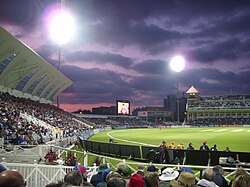Day/night cricket

Day/night cricket, also known as floodlit cricket, is a
In October 2012, the International Cricket Council recast the playing conditions for Test matches, permitting day/night Test matches.[2] The first day/night Test Match took place between Australia and New Zealand at the Adelaide Oval, Adelaide on 27 November 2015, 36 years to the day from the first ICC-sanctioned day/night match.
History

Although the idea was birthed in the western Adelaide suburb of Cowandilla in the 1930s,[3][4] which led to an 11 team Electric Light Cricket competition there in the 1930s,[5] it is believed that the first match played under floodlights in England was on 11 August 1952, between Middlesex County Cricket Club and Arsenal Football Club.[citation needed] The match was a benefit for Jack Young, and was not the first benefit match held between the two sides. Floodlights at Arsenal Stadium had been installed in the summer of 1951, and were first used for football in October 1951. The cricket match took place at 19:30, the lights were turned on towards the end of the first innings, in which Arsenal were batting. A public announcement was made, advising spectators (of which there were just over 7,000) to "Keep your eye on the ball, when you see it coming keep low. The batsmen will try to keep it down, but they can't promise." The match was televised on the BBC, with over a million viewers tuning in to watch the spectacle. The Times was not convinced of the success of floodlights in cricket, mischievously asking: "What is to prevent non-stop Test matches where the last wicket falls as the milkman arrives?"[6]
It appeared that the cricketing world concurred with The Times that playing cricket under floodlights was not a viable concept, and for over twenty years Jack Young's benefit remained a one-off. However, in 1977, when
Floodlit cricket was soon taking place not only in Australia, but also in South Africa, the
Day/night first-class matches


During the late 2000s, discussions regarding the possibility of playing day/night Test matches occurred. In the West Indies, the first floodlit first-class cricket match in which the teams used a pink ball, was played between Guyana and Trinidad and Tobago.[10] The viability of using a pink ball was also tried out by Cricket Australia and some Indian Premier League and Bangladesh Cricket League franchises.[11] The annual curtain-raiser to the English cricket season in 2010 was played under floodlights in Abu Dhabi, with a mixed but generally positive reception.[12] A year later, in 2011, the first County Championship game to be played under lights was played, between Kent and Glamorgan at St Lawrence Ground, Canterbury.[13]
The 2013–14 Sheffield Shield season included three-day/night first-class matches with pink balls.[14] The trials continued in 2014–15 as Cricket Australia looked to host the first day-night Test in 2015 against New Zealand.[15] This match took place at the Adelaide Oval, Adelaide on 27 November 2015.[16]
India's first pink ball match took place in Kolkata on 18 July 2016. It was CAB Super League Final between Bhowanipore Club and Mohan Bagan.[
The second day/night Test took place between Pakistan and the West Indies on 13–17 October 2016.[19] In October 2016 the England and Wales Cricket Board (ECB) confirmed that the first Test between England and the West Indies in August 2017 would be played as a day/night game.[20]
On 7 March 2017, Cricket Australia confirmed that the first day/night
First international day/night matches by host country
Men's
List of day/night Tests
Men's
Women's
| No. | Date | Home team | Away team | Venue | Result |
|---|---|---|---|---|---|
| 1 | 9–12 November 2017 |
North Sydney Oval, Sydney | Match drawn | ||
| 2 | 30 September–3 October 2021 | Carrara Stadium, Gold Coast, Queensland | Match drawn |
References
- ^ "Bulb breaks on nights in whites". ESPNcricinfo. Retrieved 20 February 2011.
- ^ "ICC paves way for Day-Night Tests". Wisden India. 29 October 2012. Archived from the original on 30 June 2015. Retrieved 22 November 2015.
- ^ "Electric Light Cricket". The ABC. Retrieved 23 May 2021.
- ^ "The Mail". 7000 Play It Now. 9 April 1949.
- ^ "Electric Light Cricket; Returned Soldiers Invent New Game". The Adelaide Advertiser. 2 November 1934. p. 13. Retrieved 9 July 2022.
- ^ Williamson, Martin (11 March 2006). "Let there be light". ESPNcricinfo. Retrieved 20 February 2011.
- ^ a b Williamson, Martin. "World Series Cricket". ESPNcricinfo. Retrieved 20 February 2011.
- ^ "1st match: Australia v West Indies at Sydney, Nov 27, 1979". ESPNcricinfo. Retrieved 20 February 2011.
- ^ "Henry Blofeld: Future still looks dim for floodlit cricket in England". The Independent. independent. independent. 7 January 2014. Retrieved 7 January 2014.
- ^ Cricinfo staff (16 January 2010). "Simmons century inaugurates first floodlit game". ESPNcricinfo. Retrieved 20 February 2011.
- ^ Hobson, Richard (29 March 2010). "MCC hopes pink ball can pass desert trial in season opener". The Times. London. Retrieved 20 February 2011.
- ^ "Durham dominate MCC in Abu Dhabi". BBC Sport. 29 March 2010. Retrieved 20 February 2011.
- ^ "Kent get mixed floodlit reaction". BBC News. 9 September 2011.
- ^ "New look domestic schedule announced". Cricket Australia. 7 September 2013. Archived from the original on 9 September 2013. Retrieved 7 September 2013.
- ^ Coverdale, Brydon (23 June 2014). "Australia's summer schedule released". Cricinfo. ESPN. Retrieved 13 November 2014.
- ^ "First day-night Test for Adelaide Oval". ESPNCricinfo. 29 June 2015. Retrieved 29 June 2015.
- ^ "Pink is camera friendly, but a day-night Test far away". Cricbuzz. Retrieved 31 August 2016.
- ^ "No home day-night Test this season - Thakur". ESPN Cricinfo. Retrieved 27 September 2016.
- ^ "Pakistan and West Indies to play day-night Test in Dubai". BBC Sport. Retrieved 7 October 2016.
- ^ "Edgbaston to host England-West Indies day-night Test". ESPN Cricinfo. 6 October 2016. Retrieved 7 October 2016.
- ^ "Southern Stars set for historic day-night Test". Cricket Australia. Retrieved 7 March 2017.
